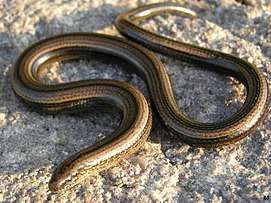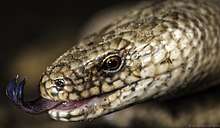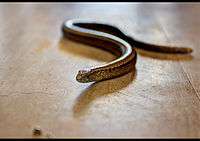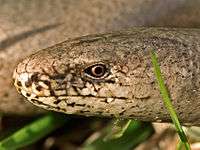Anguis fragilis
Anguis fragilis is a reptile native to Eurasia. It is also called a deaf adder, a slowworm,[2] a blindworm, or regionally, a long-cripple, to distinguish it from the Peloponnese slowworm. These legless lizards are also sometimes called common slowworms. The "blind" in blindworm refers to the lizard's small eyes, similar to a blindsnake (although the slowworm's eyes are functional).
| Anguis fragilis | |
|---|---|
 | |
| Scientific classification | |
| Kingdom: | Animalia |
| Phylum: | Chordata |
| Class: | Reptilia |
| Order: | Squamata |
| Family: | Anguidae |
| Genus: | Anguis |
| Species: | A. fragilis |
| Binomial name | |
| Anguis fragilis | |
Slowworms are semifossorial[3] (burrowing) lizards, spending much of their time hiding underneath objects. The skin of slowworms is smooth with scales that do not overlap one another. Like many other lizards, they autotomize, meaning that they have the ability to shed their tails to escape predators. While the tail regrows, it does not reach its original length. In the UK, they are common in gardens, and can be encouraged to enter and help remove pest insects by placing black plastic or a piece of tin on the ground. On warm days, one or more slowworms can often be found underneath these heat collectors. One of the biggest causes of mortality in slowworms in suburban areas is the domestic cat, against which it has no defence.
Physical traits

These reptiles are mostly active during the twilight and occasionally bask in the sun, but are more often found hiding beneath rocks and logs. They are carnivorous and, because they feed on slugs and worms, they can often be found in long grass and other damp environments.
The females give birth to live young (ovoviviparous birth). In the days leading up to birth, the female can often be seen basking in the sun on a warm road.
Although these lizards are often mistaken for snakes, a number of features differentiate them. The most important one is that they have small eyes with eyelids that, like other lizards, blink. Unlike snakes, they may also have visible ears. They shed their skin in patches, whereas most snakes shed their skins whole. Slowworms may also shed their tails (autotomy) as a defence mechanism, by breaking one of their tail vertebrae in half. The pattern of a slowworm's ventral scales is also different from that of a snake's.
Size and longevity
Adult slowworms grow to be about 50 cm long, and are known for their exceptionally long lives; the slowworm may be the longest-living lizard, living about 30 years in the wild and up to at least 54 years in captivity (this record is held by a male slowworm that lived at the Copenhagen Zoo from 1892 until 1946, the age when first obtained is unknown).[4][5] The female often has a stripe along the spine and dark sides, while the male may have blue spots dorsally. Juveniles of both sexes are gold with dark brown bellies and sides with a dark stripe along the spine.
Protected status in the UK
In the United Kingdom, the slowworm has been granted protected status, alongside all other native British reptile species. The slowworm has been decreasing in numbers, and under the Wildlife and Countryside Act 1981, to intentionally kill, injure, sell, or advertise to sell them is illegal.[6][7]
Ireland
The slowworm is not native to Ireland, but is believed to have been illegally introduced in the 1970s. It has been sighted only in parts of County Clare, mainly in the Burren region.[8][9][10]
Taxonomy
The subspecies A. f. fragilis is found all over Europe, while A. f. colchicus is found in southeastern Europe, the Caucasus, and Iran.
Gallery
 Slowworm close
Slowworm close- Slowworm in hand
.jpg) A slowworm head
A slowworm head

See also
References
- https://www.iucnredlist.org/species/157249/5060016
- The "slow-" in slowworm is distinct from the English adjective slow ("not fast"); the word comes from Old English slāwyrm, where slā- means 'earthworm' or 'slowworm' and wyrm means "serpent, reptile". ("Slowworm". The American Heritage Dictionary of the English Language. Houghton Mifflin Harcourt. 2017.)
- "Feeding state and selected body temperatures in the slowworm" (PDF). Herpetological Journal. 18: 59–62. 2008. Archived from the original (pdf) on 17 June 2009. Retrieved 2009-06-03.
- Smith, Malcolm (1951). "The British Amphibians and Reptiles". Archived from the original on 2017-09-16.
- "Slow Worm".
- "BBC - Science & Nature - Wildfacts - Slow worm". BBC. Archived from the original on 4 May 2007. Retrieved 2007-05-16.
- "Wildlife and Countryside Act 1981". Legislation.gov.uk. Retrieved 20 September 2015.
- Irish Wildlife Trust Lizard Survey
- "Archived copy" (PDF). Archived from the original (PDF) on 2014-02-03. Retrieved 2014-01-25.CS1 maint: archived copy as title (link)
- Slowworm makes its entrance, by Dick Warner. Irish Examiner, March 18, 2013
External links

